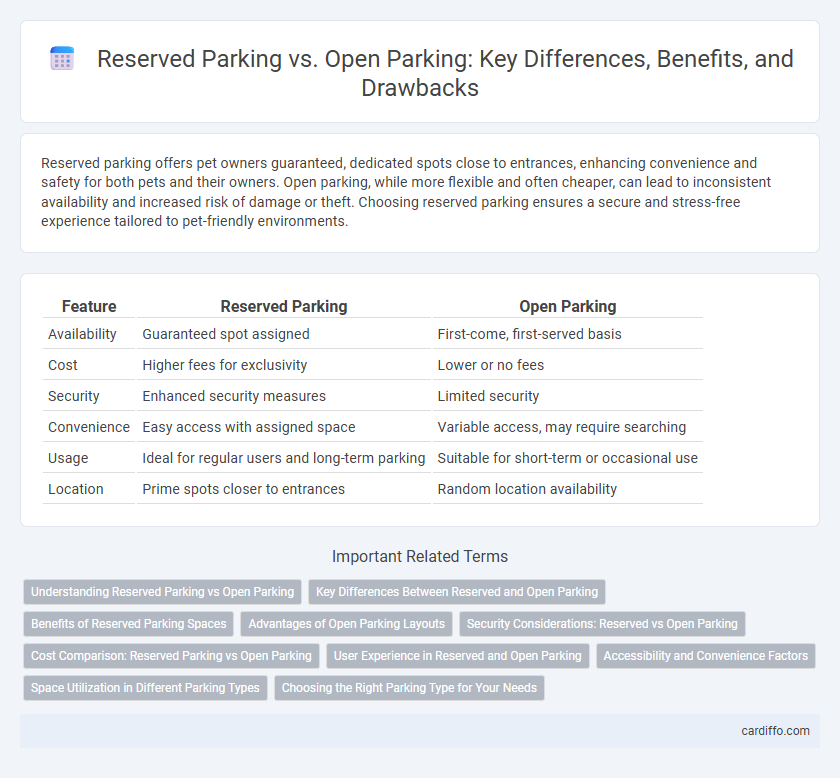Reserved parking offers pet owners guaranteed, dedicated spots close to entrances, enhancing convenience and safety for both pets and their owners. Open parking, while more flexible and often cheaper, can lead to inconsistent availability and increased risk of damage or theft. Choosing reserved parking ensures a secure and stress-free experience tailored to pet-friendly environments.
Table of Comparison
| Feature | Reserved Parking | Open Parking |
|---|---|---|
| Availability | Guaranteed spot assigned | First-come, first-served basis |
| Cost | Higher fees for exclusivity | Lower or no fees |
| Security | Enhanced security measures | Limited security |
| Convenience | Easy access with assigned space | Variable access, may require searching |
| Usage | Ideal for regular users and long-term parking | Suitable for short-term or occasional use |
| Location | Prime spots closer to entrances | Random location availability |
Understanding Reserved Parking vs Open Parking
Reserved parking guarantees a specific space for a vehicle, offering convenience and security in high-demand areas. Open parking allows drivers to use any available spot without prior allocation, providing flexibility but less certainty. Understanding these differences helps individuals and businesses optimize parking management based on their needs.
Key Differences Between Reserved and Open Parking
Reserved parking spaces guarantee a specific spot for authorized users, ensuring consistent availability and convenience, while open parking offers first-come, first-served access, often resulting in variable availability and less predictability. Reserved parking typically involves a subscription or fee, providing enhanced security and exclusivity, whereas open parking is generally free or pay-per-use, catering to short-term or casual parkers. These differences impact user experience, cost, and accessibility, making reserved parking ideal for regular commuters and open parking suitable for occasional visitors.
Benefits of Reserved Parking Spaces
Reserved parking spaces offer increased convenience by guaranteeing a specific spot, reducing time spent searching for parking. These spaces enhance security, as they are often monitored or located closer to entry points, minimizing risks of theft or damage. Businesses and residential complexes benefit from improved organization and customer satisfaction through the allocation of reserved parking.
Advantages of Open Parking Layouts
Open parking layouts maximize space utilization by allowing flexible vehicle placement without fixed boundaries, increasing overall capacity compared to reserved spots. They also reduce management complexity and maintenance costs since no individual space allocation or monitoring is needed. This design enhances traffic flow and accessibility, making it easier for drivers to find available spots quickly.
Security Considerations: Reserved vs Open Parking
Reserved parking offers enhanced security through controlled access and assigned spaces, reducing the risk of theft and unauthorized use. Open parking areas, while convenient, often lack surveillance and designated spots, increasing vulnerability to vehicle damage and theft. Installing security measures such as cameras and proper lighting can mitigate risks in both reserved and open parking environments.
Cost Comparison: Reserved Parking vs Open Parking
Reserved parking spaces typically incur higher costs due to guaranteed availability and increased security features, often ranging from 20% to 50% more than open parking spots. Open parking, while more economical, may lack predictability and protection, with prices influenced by location and demand but generally remaining lower than reserved options. Businesses and individuals must weigh these cost differences against convenience and risk factors when selecting their parking solution.
User Experience in Reserved and Open Parking
Reserved parking offers users guaranteed spaces, reducing search time and stress, which significantly enhances convenience and satisfaction. Open parking provides flexibility and can accommodate more vehicles, but often leads to longer search times and uncertainty, impacting the overall user experience negatively. Optimal user experience depends on balancing the reliability of reserved spots with the accessibility and availability provided by open parking areas.
Accessibility and Convenience Factors
Reserved parking offers guaranteed access to a specific spot, significantly enhancing convenience for users by eliminating the need to search for available spaces. Open parking provides greater flexibility and accessibility, accommodating fluctuating vehicle volumes and promoting ease of entry for short-term or spontaneous visits. Accessibility in reserved parking is tailored, often supporting individuals with disabilities or frequent users, while open parking maximizes overall space utilization for a diverse range of drivers.
Space Utilization in Different Parking Types
Reserved parking optimizes space utilization by allocating specific spots to individuals or vehicles, reducing conflicts and ensuring efficient use of areas in high-demand locations. Open parking offers flexibility by allowing dynamic allocation of available spaces, which can increase overall occupancy but may lead to underutilization during low-demand periods. Effective space management depends on balancing predictability in reserved parking with adaptability in open parking structures.
Choosing the Right Parking Type for Your Needs
Reserved parking offers guaranteed spaces, ideal for daily commuters or employees who require consistent access, enhancing convenience and security. Open parking provides flexibility and is often cost-effective for visitors or occasional parkers, accommodating variable demand without long-term commitments. Evaluating factors such as usage frequency, budget, and location accessibility will guide the choice between reserved and open parking solutions.
Reserved Parking vs Open Parking Infographic

 cardiffo.com
cardiffo.com